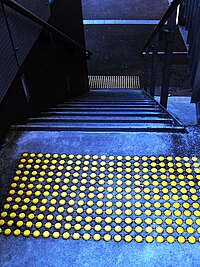
Photo from wikipedia
Neural interactions between upper and lower limbs underlie motor coordination in humans. Specifically, upper limb voluntary muscle contraction can facilitate spinal and corticospinal excitability of the lower limb muscles. However,… Click to show full abstract
Neural interactions between upper and lower limbs underlie motor coordination in humans. Specifically, upper limb voluntary muscle contraction can facilitate spinal and corticospinal excitability of the lower limb muscles. However, little remains known on the involvement of somatosensory information in arm‐leg neural interactions. Here, we investigated effects of voluntary and electrically induced wrist flexion on corticospinal excitability and somatosensory information processing of the lower limbs. In Experiment 1, we measured transcranial magnetic stimulation (TMS)‐evoked motor evoked potentials (MEPs) of the resting soleus (SOL) muscle at rest or during voluntary or neuromuscular electrical stimulation (NMES)‐induced wrist flexion. The wrist flexion force was matched to 10% of the maximum voluntary contraction (MVC). We found that SOL MEPs were significantly increased during voluntary, but not NMES‐induced, wrist flexion, compared to the rest (P < .001). In Experiment 2, we examined somatosensory evoked potentials (SEPs) following tibial nerve stimulation under the same conditions. The results showed that SEPs were unchanged during both voluntary and NMES‐induced wrist flexion. In Experiment 3, we examined the modulation of SEPs during 10%, 20% and 30% MVC voluntary wrist flexion. During 30% MVC voluntary wrist flexion, P50‐N70 SEP component was significantly attenuated compared to the rest (P = .003). Our results propose that the somatosensory information generated by NMES‐induced upper limb muscle contractions may have a limited effect on corticospinal excitability and somatosensory information processing of the lower limbs. However, voluntary wrist flexion modulated corticospinal excitability and somatosensory information processing of the lower limbs via motor areas.
Journal Title: European Journal of Neuroscience
Year Published: 2022
Link to full text (if available)
Share on Social Media: Sign Up to like & get
recommendations!